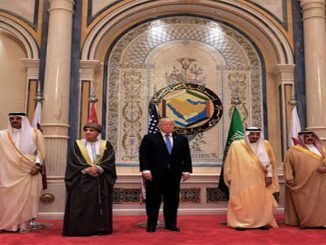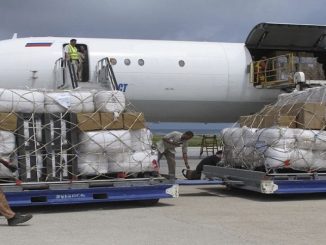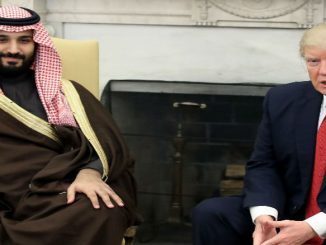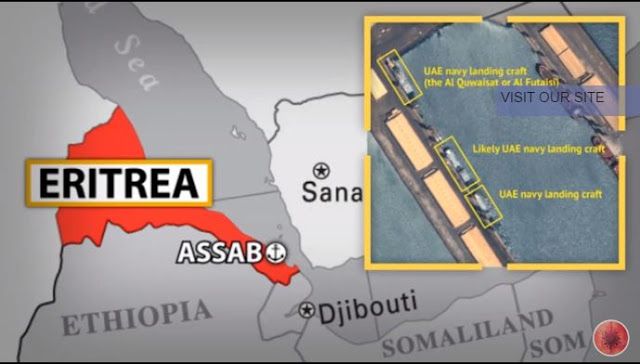
Britain militarily withdrew from areas “east of Suez” in 1971, triggering the Trucial States to form today’s United Arab Emirates. Now, 45 years later, this Arab country is increasingly focused on projecting military power “west of Suez”, outlined Alex Mello the security analyst at Horizon Client, and Michael Knights, the fellow at the Washington Institute for Near East Policy.
According to a report titled “West of Suez of the United Arab Emirates” and published on The War On The Rocks, the establishment of projection bases on the Horn of Africa is the principal ambition for the Emirati power, saying the rise of the Islamic State has convinced Emirati leaders to become more active in managing the risks facing their federation.
The analysts conclude that the United Arab Emirates aims to gain a leading role in the protection of the Suez and Bab el-Mandab sea-lanes, particularly with the development of its closer military relationship with Egypt and Sudan, and the construction of a major decades-spanning power projection base in Eritrea.
The Emirati naval and air base at Assab port particulary aims to blockade the Houthi-held ports on the Red Sea and preventing Iran from resupplying the rebels.
The progression of Emirati expeditionary operations is fascinating to retrace. In the 1980s and 1990s, the Emirates sent de-mining forces to Lebanon, peacekeepers to Somalia, and Apache attack helicopters to the NATO intervention in Kosovo, according to the report.
Eritrea a major UAE base
the analysis revealed that the Emirates turned towards the Horn of Africa and Indian Ocean Concurrently with its intervention in Yemen, to halt the advance of Yemen’s Houthi militia.
At that time, Saudi Arabia and the Emirates initially sought to use Djibouti, just across the Gulf of Aden, to support the liberation of Aden, but a twist of fate intervened, but an altercation between the chief of the Djibouti Air Force and Emirati diplomats derailed relations between the two countries
This dispute escalated quickly due to pre-existing tensions concerning a long-running legal dispute over the contract for the Doraleh Container Terminal, the largest container port in Africa, operated by Dubai Ports World, the Dubai-based Emirati port operator and one of the biggest U.A.E. soft-power assets.
On May 4, 2015, the United Arab Emirates and Djibouti formally broke off diplomatic relations. Djibouti evicted Saudi and Emirati troops from a facility at Haramous, adjacent to Camp Lemonnier.
In Eritrea specially in the Southern Red Sea Region, as part of the partnership agreement, the United Arab Emirates concluded a 30-year lease agreement for military use of the mothballed deep-water port at Assab and the nearby hard-surface Assab airfield, with a 3,500-meter runway capable of landing large transport aircraft including the huge C-17 Globemaster transports flown by the Emirati air force.
The first Emirati power projection site outside the federation’s homeland “Assab”, urged the Gulf states to provide a financial aid package and undertook to modernize Asmara International Airport, build new infrastructure, and increase fuel supplies to Eritrea.
The early operations at Assab were hasty but effective. On April 13, a CH-47 Chinook carried an eight-man team of Emirati Presidential Guard special operators and Joint Terminal Attack Controllers (JTACs) into the Little Aden peninsula, the site of Aden’s refinery and oil storage tanks. These forces called in airstrikes and naval gunfire missions, enabling forces loyal to President Abdu Rabu Mansour Hadi and local Aden popular resistance committees to hang onto two defensive pockets with their backs to the sea. Emirati landing ships dropped Saudi and Emirati security forces and U.A.E.-trained local militias mounted into the defensive pockets in May.
In mid-July 2015, the Emirati battlegroup began landing at the Little Aden oil terminal.
In October and November 2015, Assab served as the logistics hub for the deployment of three 450-man Sudanese mechanized battalions to Aden. The two Sudanese battalions undertook a lengthy route movement from Kassala on the Sudan-Eritrea border to Assab port and were shuttled across to Aden by U.A.E. vessels.
Assab port also served as the base for the Gulf naval blockade of the Red Sea ports of Mokha and Hodeida, with several Emirati navy vessels including new Baynunah-class corvettes and Rmah-class logistics vessels docking at the port through late 2015 and 2016.
Since the offensive against al-Qaeda in the Arabian Peninsula (AQAP) in Hadhramout in April 2016, Assab has also served as a transshipment hub for Emirati vessels delivering humanitarian aid and reconstruction materials, including generators and fuel to Mukalla.
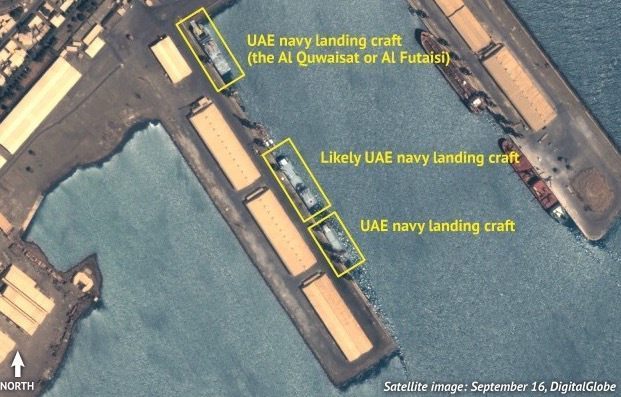
“Assab” port..aerial hub and training base
the analysis revealed that Emirati turned the site of “Assab” from an austere forward operating location into a powerful expeditionary baseforces, saying by early 2016, the airfield was hosting several Apache attack helicopters of the Emirati Joint Aviation Command as well as Presidential Guards’ Special Operations Command Chinook, Black Hawk, and Bell 407MRH helicopters conducting operations over southwest Yemen.
In October 2015, New Yemeni air corps pilots trained on U.A.E.-donated aircraft at Assab prior to their transfer to Al-Anad Air Base to the north of Aden, outlined the analysts.
In late 2015, the United Arab Emirates also began constructing new deep-water port facilities on the coast directly adjacent to Assab airfield, removing the need for U.A.E. military convoys to transit through Assab city as they travelled from the airbase to the port ten kilometers to the south.
Saudi Arabia and UAE are competitors in Horn of Africa
Saudi Arabia and the United Arab Emirates have cooperated in major security ventures, but the two leading Gulf Cooperation Council military powers are also competitors.
In Yemen for example, the objectives of the two Gulf States are slowly diverging, with the Saudis backing Islamist militias against the Houthis in the north, whilst the United Arab Emirates is focused on countering AQAP in the south of the country.
In the Horn of Africa region there are signs of competition as well. Saudi Arabia patched things up with Djibouti by October 2015, with Saudi access restored to the airfield at Camp Lemonier and with Djibouti receiving Saudi-donated patrol boats, helicopters, weapons, and ambulances.
In March 2016, discussions were underway between Riyadh and Djibouti for the signing of comprehensive bilateral security agreement including the return of a long-term Saudi military base to Djibouti.
The Emiratis appear to be adopting a broader-based approach to the Horn of Africa, East Africa, and Indian Ocean region. Abu Dhabi has long been a generous benefactor and investor in the Indian Ocean island-states such as the Seychelles, Maldives, Mauritius, Madagascar, and the Comoros.
In these areas, the large Emirati investment banks and foundations have supported tourism, ports, and humanitarian projects. The United Arab Emirates is interested in East Africa also, with natural gas, ports, and food security in mind.
To support the development of a broader Indian Ocean and East Africa policy the United Arab Emirates is getting drawn into security cooperation relationships with a range of Horn of Africa states, aiming to reduce instability and the growth of Islamist militias in the region.
UAE ‘s ambitions in Somalia and Somaliland
In early May 2015, the United Arab Emirates expanded its long-running train and equip partnership with Somalia’s counterterrorism unit and National Intelligence and Security Agency (NISA), opening a new U.A.E.-funded training center in Mogadishu where Emirati special forces operators have trained several units of Somali commandos.
In late May 2015, the Emirates supplied the Interim Jubba Administration at Kismayo with a batch of RG-31 Mk. V MRAPs and Toyota Land Cruisers. These were followed in June by a shipment of Reva Mk. III armored personnel carriers, water tanker trucks, and police motorcycles for the Somali federal government’s Ministry of Internal Security and Police.
In October 2015, the United Arab Emirates pledged to pay the salaries of the Somali federal government security forces over a four-year period.
The United Arab Emirates has also wooed Somalia’s regional rival, the autonomous Somaliland region.
In May 2016, Dubai Ports World won a 30-year contract to manage the port of Berbera and expand it into a regional logistics hub, breaking up Djibouti’s virtual monopoly on Ethiopian freight via the Doraleh Container Terminal through the joint development by Somaliland and Ethiopia of the Berbera Corridor as an alternative logistics route.
The United Arab Emirates is also said to be seeking access to the Berbera port and airstrip to support its operations in Yemen, and may provide Somaliland with a financial aid package and an Emirati-built military training center.
In Puntland, an autonomous region in northeastern Somalia, the United Arab Emirates also paid for the Puntland Maritime Police Force to be established in 2010, with anti-piracy training provided by a succession of private security companies, a cause for some controversy.
The UAE also finances and trains the Puntland Intelligence Agency. When the Gulf Coalition naval blockade sought to interdict Iranian weapons smuggling to the Houthis, the Emirati investment in Puntland and Somaliland seemed to have paid off, shutting off known Iranian transshipment points like Bosaso and Berbera.


